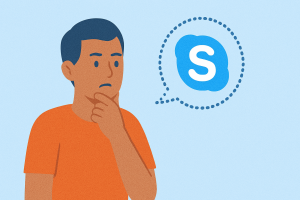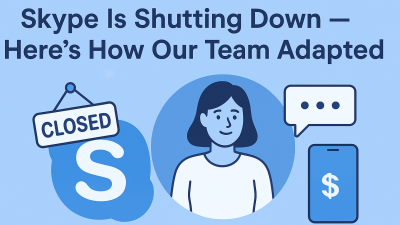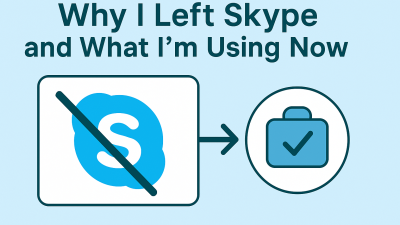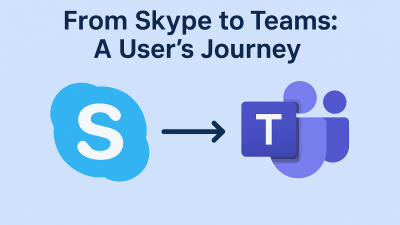Not because it was groundbreaking technology, though it was. Not because it was the first of its kind — it wasn’t. You remember it because something about Skype made distance smaller in a way nothing else quite had before.
It wasn’t polished. The connection dropped. The camera stuttered. But the moment your screen lit up and you saw someone you hadn’t seen in months — someone who lived ten time zones away — it was enough. More than enough.
Skype made international conversation casual. You didn’t need a calling card. You didn’t need a monthly plan. You just needed Wi-Fi and a reason to connect. And if you lived far from your family, if you were in a long-distance relationship, if you had a freelance client in another city, you had a reason.
The Blue Icon Was More Than a Logo — It Was a Signal
There’s something about icons — the little ones that live quietly in your taskbar or phone screen. Some fade into the background. Others become part of your daily rhythm. The blue Skype icon belonged to the second group.
When that icon turned green, it wasn’t just about status. It was about presence. You saw it light up and knew someone was there, someone was reachable. You could call, talk, hear their voice, see their face. And you could do it without needing to ask, “can I afford this minute?”
It became the background of conversations that shaped people’s lives. Not the centerpiece — the background. Quietly reliable. Consistently available. That’s where Skype found its value. Not in flash, but in consistency. In becoming part of people’s routines, not just their tech stack.
Skype Was the Platform of Long-Distance Everything
You can’t talk about Skype without talking about distance — and not just physical.
It shortened emotional distance too. It offered something incredibly rare for its time: the ability to see someone while you spoke to them. Not just hear their voice. Not just read a message.
That small shift — from sound to sight — changed everything.
Couples used it to stay close when they were oceans apart. Families used it to watch grandkids grow up from another continent. Students studied abroad and stayed grounded by calling home without worrying about the bill. Founders pitched investors through shaky webcams. Journalists filed stories from war zones.
And for millions of people, it became the only way they could afford to stay in each other’s lives.
Skype didn’t build itself around a brand voice or an aesthetic. It was functional. Sometimes frustrating. Often laggy. But it worked, well enough to carry real emotion through a screen. That made it irreplaceable for a long time.
Skype Didn’t Just Make Calls Free — It Made Them Possible

Before Skype, international calls weren’t normal. They were scheduled. You waited until Sunday, when rates were lowest. You kept a stopwatch next to the phone. Every minute ticked against a budget.
Skype broke that model. Completely.
Suddenly, talking to someone in another country became as easy as double-clicking a name. The limitations weren’t financial anymore, they were emotional, logistical, or technical. And even then, it created a new social behavior: talking because you could, not just because you had to.
That shift changed how relationships worked. It changed how freelancers grew. It changed how families stayed together, even while spread across time zones and continents.
No app can claim it “connected the world.” But Skype, for a good decade, came as close as any tool ever has.
It Wasn’t Built to Be Perfect — It Was Built to Be There
Every Skype user has a story that starts with “the call dropped but…”
The video froze. The sound echoed. Someone’s mic didn’t work. But none of that stopped the call. It never stopped the call.
Skype taught people that connectivity didn’t have to be clean to be meaningful. The image might buffer, but the presence was there. The voice might glitch, but the intention stayed solid.
That kind of imperfect presence is something newer apps, for all their gloss, struggle to offer. They’re built for clarity, not for comfort. They optimize for UX, not for intimacy.
Skype didn’t try to remove friction — it made the friction tolerable because it gave you access you couldn’t get anywhere else. And we forgave a lot, because what it gave us in return wasn’t a product — it was people.
The Shift Away Wasn’t Immediate — But It Was Inevitable
Skype didn’t disappear in a crash. It drifted. Slowly, then suddenly.
As smartphones took over, it lagged behind. As Zoom simplified business calls and WhatsApp owns mobile video, Skype’s identity got blurry. Microsoft tried to fix it — redesigned the interface, added emojis, rolled out Skype for Business, but the core feeling that made Skype matter started to erode.
It became heavier. Slower. Cluttered. Updates started solving problems no one had asked for, while ignoring the ones users brought up in forums and threads.
And then, during the moment when the whole world went remote, when everyone was calling, every day, for everything, Skype wasn’t the app people opened. That window closed quietly. Not with drama. With disinterest.
Why This Shutdown Feels Different Than Most
Apps come and go. Platforms shut down all the time. But there’s a reason Skype’s retirement hits harder than most.
This wasn’t a social network that faded out with a trend. It wasn’t an app that got replaced by something cooler. Skype wasn’t cool. It was dependable. It was never about status — it was about staying in touch.
And now, something you didn’t think twice about opening — that app you always kept on your desktop “just in case” — is being retired. Quietly. Permanently.
There’s no viral goodbye campaign. No farewell livestream. Just a date: May 5, 2025, and a message from Microsoft telling you it’s time to move on.
What makes it harder is how personal this loss feels, even if we don’t want to admit it. Because for a lot of people, Skype wasn’t just a utility. It was the stage where their relationships grew, survived, and sometimes ended.
The Grief You Didn’t Expect to Feel
You don’t grieve an app, right?
But then you open Skype one last time, scroll through years of conversations, and realize how much of your life happened there. You see your name next to someone who’s not here anymore. You find the first messages with the person you now live with. You replay a call recording from when you were halfway across the world, trying to make a decision that changed everything.
That’s when it hits you.
Skype became the container for conversations that shaped your life. It was where hard decisions were made, where comfort was delivered, where birthdays were sung across bad audio. And because it wasn’t flashy or public, those conversations stayed private, quietly etched into a feed only you could see.
Losing that feels like losing a corner of your memory. Not because you can’t technically back it up. But because you’re not going to. And you know it.
When Technology Gets Replaced, Something Else Gets Lost Too
Microsoft wants you to use Teams now. And sure, it’s more powerful. It does more. It fits the current direction of work, communication, and integration.
But that doesn’t mean it fits you.
Teams is structured. It’s optimized. It’s built for productivity. But Skype was built for presence. For calling someone not because you had a meeting, but because you missed them. It didn’t have to justify itself with features. It just had to connect you.
There’s a specific kind of silence that comes when a technology you trusted disappears — not because it failed, but because the world decided it no longer fit.
Skype is being replaced, not because it couldn’t work, but because Microsoft no longer sees it as part of the future it’s building. That’s the cost of consolidation. When tools get absorbed into bigger systems, they stop being personal. They become a strategy.
The Stories We Don’t Want to Lose
You’ve probably seen the threads.
Reddit. Twitter. Quiet LinkedIn posts. People reminisce about the hours they spent on Skype long before video calls became common. Couples who navigated years of long-distance. Kids talking to grandparents across oceans. Parents hear their child’s voice from a war zone. Friends falling asleep on calls. Bands rehearsing together from different cities.
These weren’t extraordinary uses of technology, they were human stories that happened because the tech allowed it.
And now people are sharing screenshots. Saving chat logs. Re-downloading recordings. Because once Skype is gone, that little world disappears too.
It’s not about resisting change. It’s about holding onto what was real — even if it was pixelated, laggy, or locked inside a chat window from 2014.
Why We Remember the Imperfect Stuff
When we talk about Skype, we don’t talk about innovation. We talk about experience.
Not the experience of the app, but the experience through it.
Skype was awkward. The UI wasn’t great. The mobile version took too long to load. But somehow, all of that made it better. More honest. More human. It didn’t try to be sleek. It just wanted to connect you. And it mostly did.
And maybe that’s what made it special. It didn’t distract. It didn’t chase trends. It didn’t try to entertain you. It stayed in the background until you needed it.
That kind of technology is rare now — software that stays quiet and loyal.
There’s No Replacement for What Skype Represented

Yes, there are apps that do what Skype did, and more. Zoom is smoother. WhatsApp is faster. Google Meet is cleaner. But none of them carries the same emotional weight. Not because Skype was better, but because it came first. It arrived at a time when we needed it in ways we couldn’t articulate yet.
You don’t get a second first love. And you don’t get a second Skype.
That’s not nostalgia, that’s reality.
Before You Close Skype for the Last Time
If you haven’t already, open the app. Just once more.
Not to make a call. Not to export data. Just to look.
Scroll through your old conversations. Look at your contacts. Notice the usernames you forgot about. The dates you didn’t realize meant something. The tiny conversations that felt small in the moment but now feel like time capsules.
Maybe you’ll download your data. Maybe you won’t. But spend a moment there—before it shuts down for good—and give yourself space to remember what it meant.
Saying Goodbye Isn’t Just for the App — It’s for the Era
Skype came from a different internet. One that wasn’t always fast, but was full of possibility. It arrived before the feeds, before the filters, before “join with link” became the default.
It helped us figure out how to be present from a distance. And even though it couldn’t keep up with the world it helped shape, it gave us something lasting.
And now, as we move to Teams, Zoom, or wherever the next call happens, we carry that forward — not the app, but the memory of what it made possible.
That matters more than we tend to admit.



